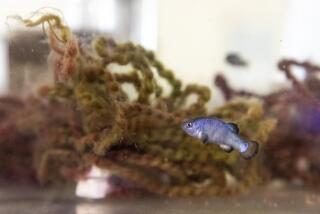Op-Ed: Saline lakes are drying up across the West — and putting birds at serious risk
Utah’s Great Salt Lake is a critical rest stop for millions of birds that make the long, biannual migration across the arid West. In the fall, you might see millions of water birds on the lake gorging on shrimp.
This may not be the case for much longer. Over the past 150 years, the Great Salt Lake has shrunk by nearly 50%. It’s not an isolated case. In a new study on the effects of water loss and climate change on birds, the National Audubon Society has found that, of the nine western saline lakes most important to birds, more than half have shriveled by 50% to 95%.
Because water birds in the West depend on the region’s entire network of salt lakes, these declines could be catastrophic for the global populations of some species. For instance, 99% of the North American population of eared grebes — small waterfowl distinguished by bright red eyes that are framed by sassy tufts of golden feathers — depends on western saline lakes to survive their long migrations. What’s more, dams, diversions, extended drought and water demand along the Colorado River have devastated cottonwood-willow forests and other native river habitat. While this riverbank habitat accounts for less than 5% of the regional landscape, it supports more than 40% of all bird species in the Southwest.
The effects of water loss on birds tell us a lot about how falling water levels will affect humans.
The Western interior’s drying lakes and rivers are putting birds at serious risk. The fates of the southwestern willow flycatcher, the western yellow-billed cuckoo, the Yuma Ridgway’s rail, the American white pelican, the American avocet and the Wilson’s phalarope are tied directly to the health of rivers in the Colorado River Basin and saline lakes across the West.
Why should we care about the western yellow-billed cuckoo? Well, for one thing, the effects of water loss on birds tell us a lot about how falling water levels will affect humans. Birds are highly sensitive to ecological changes, which makes them excellent indicators of environmental health. When colonial seabirds start abandoning nesting sites en masse because of dramatic drops in water levels, as occurred in the Salton Sea in 2013, or are forced to relocate because of toxic dust kicked up by winds blowing across dry lake beds, we know that humans soon will feel the effects of those changes.
Consider that more than 36 million people depend on the Colorado River, as do 15% of all agricultural production in the United States. The Colorado River generates an estimated $1.4 trillion in economic productivity.
Fortunately, sensible solutions are possible. Cities, states, utility companies and private industry are coming together to decide how water should get shared. And the same methods for easing water shortages for people also can protect or restore natural habitats for birds and wildlife.
Even more encouraging, remedies using small flows of water already are working in places like the Great Salt Lake. On the lake’s southern shore, Audubon established and now manages the Gillmor sanctuary, a dry river delta that has been restored as a bird habitat. Nearly 2,000 acres have been recovered simply by delivering small amounts of freshwater to the right places at the right time. The number of water birds nesting in the sanctuary has increased significantly.
What’s good for birds is good for people, and vice versa. The Bureau of Reclamation and several major municipal water utilities have carried out an innovative conservation program across the Colorado River Basin. The Pilot System Conservation Program, as it’s called, offers compensation for voluntary reductions in water use to cities, ranchers and other heavy water users. The program estimates that it will save 100,000 acre-feet of water through incentives for switching to less water-intensive crops, increasing the efficiency of irrigation systems and other measures. The water that is saved remains in the river.
In the coming fiscal year and beyond, the West will require strong funding of federal programs to save water, help farmers and ranchers and restore ecosystems. Stakeholders at all levels need to identify and support more creative measures to increase the resilience and reliability of our water supplies. Such measures will have to include voluntary water-sharing agreements, market-based solutions and flexible water-management practices.
The West is facing a new normal, with increasing temperatures, cycles of drought and water levels that are shrinking and fluctuating more than at any time in the last century. This new normal demands a new phase of collaboration and innovation when it comes to water policy. The future of birds, and people, depends on it.
David Yarnold is president and CEO of the National Audubon Society.
Follow the Opinion section on Twitter @latimesopinion or Facebook
More to Read
A cure for the common opinion
Get thought-provoking perspectives with our weekly newsletter.
You may occasionally receive promotional content from the Los Angeles Times.






